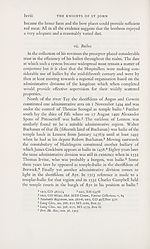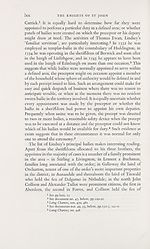Series 4 > Knights of St John of Jerusalem in Scotland
(74) Page lxix
Download files
Complete book:
Individual page:
Thumbnail gallery: Grid view | List view

INTRODUCTION
Ixix
Though these references occur at random it seems clear that well
before the date of the rental the entire country was subdivided into
bailiaries which for convenience sake appear generally to have
coincided with the administrative divisions of the kingdom.
In terms of function bailies were likewise active by the mid¬
fifteenth century giving sasine of land and presiding over courts.1
In each case they acted for and in place of the preceptor; and it
stands to reason that, as soon as it became impracticable for him to
attend personally to all transfers of land and to preside in person
whenever and wherever a court sat, some provision had to be made
for a bailie who, on assuming office, took the oath dejideli and was
protected in the discharge of his duties by making deforcement a
punishable offence.2
Whatever their origin, it is obvious that by the second decade in
the sixteenth century bailies were discharging a number of distinct
but related functions. There was in every sheriffdom a principal
bailie who combined the duties of local magistrate, land steward,
and rent collector, and wherever his commission ran he was the
preceptor’s deputy, presiding in his absence over the local court,
empowered to receive on his behalf the resignation of lands, and at
least occasionally instructing deputy bailies to give sasine, though it
would appear that much more frequently the preceptor issued the
precept to a named bailie or bailies to give sasine to the individual
concerned.3 There was also in each barony a bailie whose duties
would appear to have been restricted to presiding over the barony
court in the absence of the preceptor, giving sasine on his behalf,
and, with the aid of the sergeant, when necessary evicting tenants.4
In addition to these there was an army of bailies operating outwith
the baronies whose principal, if not their only, duty was giving
sasine.5 It is difficult to determine how far bailies were appointed on
a permanent basis, as appears to have been the case with Lindsay’s
principal bailies in sheriffdoms; though they could be removed
from office, as is made plain by the case of a bailie in Ayr and
1 See below, documents, nos. 17-18, 22, 24-5; pp.69-76, 81-82, 84-89; Laing Chrs, no.
388; Prot. Bk. Ros., no. 56; Prot. Bk. Young, no. 868; sro, RH 6/478 and 558
2 See document no. 34, below, pp.105-7
3 See document no. 49, below, pp. 132-3
4 See document no. 23, below, pp.82-84
5 See documents, nos. 35, 37, 46, 53, 57, below, pp.107-8,110-12,127-8,141-2,151-2
Ixix
Though these references occur at random it seems clear that well
before the date of the rental the entire country was subdivided into
bailiaries which for convenience sake appear generally to have
coincided with the administrative divisions of the kingdom.
In terms of function bailies were likewise active by the mid¬
fifteenth century giving sasine of land and presiding over courts.1
In each case they acted for and in place of the preceptor; and it
stands to reason that, as soon as it became impracticable for him to
attend personally to all transfers of land and to preside in person
whenever and wherever a court sat, some provision had to be made
for a bailie who, on assuming office, took the oath dejideli and was
protected in the discharge of his duties by making deforcement a
punishable offence.2
Whatever their origin, it is obvious that by the second decade in
the sixteenth century bailies were discharging a number of distinct
but related functions. There was in every sheriffdom a principal
bailie who combined the duties of local magistrate, land steward,
and rent collector, and wherever his commission ran he was the
preceptor’s deputy, presiding in his absence over the local court,
empowered to receive on his behalf the resignation of lands, and at
least occasionally instructing deputy bailies to give sasine, though it
would appear that much more frequently the preceptor issued the
precept to a named bailie or bailies to give sasine to the individual
concerned.3 There was also in each barony a bailie whose duties
would appear to have been restricted to presiding over the barony
court in the absence of the preceptor, giving sasine on his behalf,
and, with the aid of the sergeant, when necessary evicting tenants.4
In addition to these there was an army of bailies operating outwith
the baronies whose principal, if not their only, duty was giving
sasine.5 It is difficult to determine how far bailies were appointed on
a permanent basis, as appears to have been the case with Lindsay’s
principal bailies in sheriffdoms; though they could be removed
from office, as is made plain by the case of a bailie in Ayr and
1 See below, documents, nos. 17-18, 22, 24-5; pp.69-76, 81-82, 84-89; Laing Chrs, no.
388; Prot. Bk. Ros., no. 56; Prot. Bk. Young, no. 868; sro, RH 6/478 and 558
2 See document no. 34, below, pp.105-7
3 See document no. 49, below, pp. 132-3
4 See document no. 23, below, pp.82-84
5 See documents, nos. 35, 37, 46, 53, 57, below, pp.107-8,110-12,127-8,141-2,151-2
Set display mode to:
![]() Universal Viewer |
Universal Viewer | ![]() Mirador |
Large image | Transcription
Mirador |
Large image | Transcription
Images and transcriptions on this page, including medium image downloads, may be used under the Creative Commons Attribution 4.0 International Licence unless otherwise stated. ![]()
| Scottish History Society volumes > Series 4 > Knights of St John of Jerusalem in Scotland > (74) Page lxix |
|---|
| Permanent URL | https://digital.nls.uk/126638403 |
|---|
| Description | Over 180 volumes, published by the Scottish History Society, containing original sources on Scotland's history and people. With a wide range of subjects, the books collectively cover all periods from the 12th to 20th centuries, and reflect changing trends in Scottish history. Sources are accompanied by scholarly interpretation, references and bibliographies. Volumes are usually published annually, and more digitised volumes will be added as they become available. |
|---|


